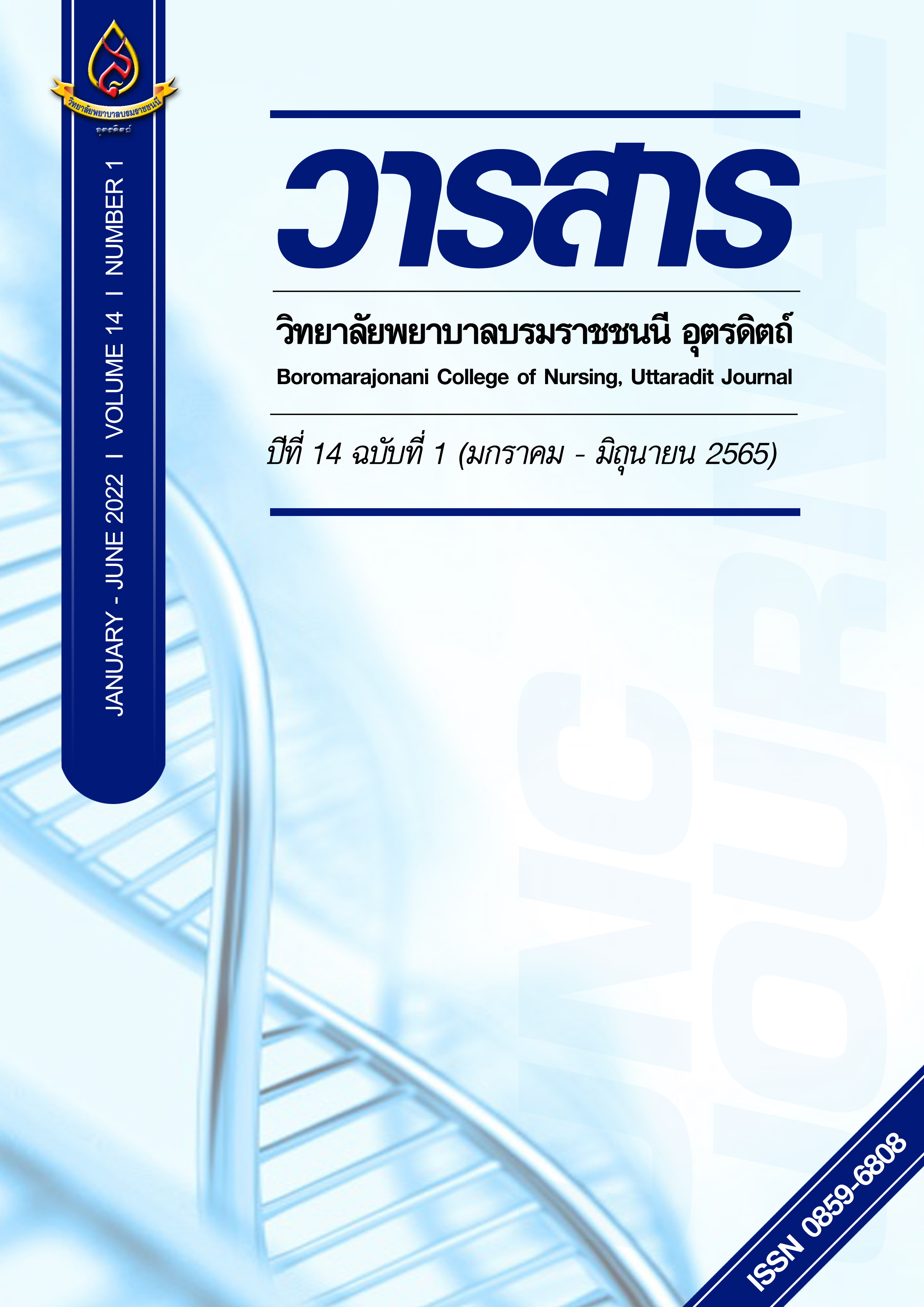การพัฒนาคุณภาพการจัดการเรียนการสอนแบบสหสาขาวิชาชีพ ตามมุมมองของอาจารย์ผู้สอนหลักสูตรวิทยาศาสตร์สุขภาพ: การวิจัยเชิงคุณภาพ
Main Article Content
บทคัดย่อ
การวิจัยเชิงคุณภาพแบบพรรณนานี้มีวัตถุประสงค์เพื่อบรรยายและอภิปรายมุมมองเกี่ยวกับการพัฒนาคุณภาพการจัดการเรียนการสอนแบบสหสาขาวิชาชีพ ของอาจารย์หลักสูตรวิทยาศาสตร์สุขภาพ ผู้ให้ข้อมูล คือ อาจารย์ที่มีประสบการณ์ในการพัฒนาและสอนนักศึกษาที่มีการเรียนการสอนแบบสหสาขาวิชาชีพ จาก วิทยาลัยพยาบาลและวิทยาลัยการสาธารณสุขสิรินธร สังกัดสถาบันพระบรมราชชนก ปีการศึกษา 2563 จำนวน 10 คน และอาจารย์พี่เลี้ยงแหล่งฝึกที่มีประสบการณ์การนิเทศนักศึกษาที่มีการเรียนการสอนแบบ สหสาขาวิชาชีพ จำนวน 10 คน เก็บรวบรวมข้อมูลโดยการสัมภาษณ์เชิงลึกรายบุคคล วิเคราะห์ข้อมูล โดยใช้วิธีการของแฮ๊ช
ผลการวิจัยพบว่า ตามมุมมองของผู้ให้ข้อมูลหลัก สามารถจำแนกประเด็นหลักที่ทำให้การจัดการเรียนการสอนแบบสหสาขาวิชาชีพมีคุณภาพมากขึ้น เป็น 3 ประเด็นหลัก และ 9 ประเด็นรอง ดังนี้คือ 1) ผู้บริหารเกื้อหนุน ในส่วนของ 1.1) เวลาและ 1.2) งบประมาณในการพัฒนานวัตกรรมของนักศึกษา 2) ออกแบบการจัด การเรียนการสอนแบบมุ่งเป้า ต่อเนื่องและเป็นจริง ตั้งแต่ 2.1) การกำหนดเป้าหมายของหลักสูตรที่ชัดเจน เพื่อพัฒนาสมรรถนะการทำงานกับสหสาขาวิชาชีพของนักศึกษา 2.2) ใส่เนื้อหาที่ส่งเสริมทักษะการทำงาน เป็นทีม 2.3) ใช้รูปแบบการสอนเชิงรุก: สภาพจริง บูรณาการ และเน้นการปฏิบัติจากง่ายไปยาก 2.4) มีการ จัดการเรียนการสอนแบบต่อเนื่อง และ 2.5) การวัดและประเมินผลที่หลากหลายทั้งเครื่องมือและผู้ประเมิน และ 3) มีครูที่เป็นต้นแบบ ทั้งในส่วนของ 3.1) การถ่ายทอดความรู้ และ 3.2) การทำงานเป็นทีม ดังนั้น สถาบันการศึกษาควรนำประเด็นเหล่านี้ไปประกอบการพิจารณาในการปรับปรุงและพัฒนาการจัดการเรียนการสอนแบบสหสาขาวิชาชีพสำหรับนักศึกษาหลักสูตรวิทยาศาสตร์สุขภาพให้มีประสิทธิภาพมากขึ้นต่อไป
Article Details

อนุญาตภายใต้เงื่อนไข Creative Commons Attribution-NonCommercial-NoDerivatives 4.0 International License.
บทความหรือข้อคิดเห็นใดใดที่ปรากฏในวารสารวิจัยการพยาบาลและวิทยาศาสตร์สุขภาพ เป็นวรรณกรรมของผู้เขียน ซึ่งบรรณาธิการหรือสมาคมศิษย์เก่า ไม่จำเป็นต้องเห็นด้วย และบทความที่ได้รับการตีพิมพ์เผยแพร่ถือเป็นลิขสิทธิ์ของวารสารวิจัยการพยาบาลและวิทยาศาสตร์สุขภาพ
เอกสารอ้างอิง
Barr, H., Wilby, K. J., Wilbur, K., & Bainbridge, L. (2016). Important steps for introducing interprofessional education into health professional education. Journal of Taibah University Medical Sciences, 11(6), 546-551.
Berger-Estilita, J., Fuchs, A., Hahn, M., Chiang, H., & Greif, R. (2020). Attitudes towards interprofessional education in the medical curriculum: A systematic review of the literature. BMC Medical Education, 254. Retrieved from https://doi.org/10.1186/s12909-020-02176-4
Bridges, D. R., Davidson, R. A., Odegard, P. S., Maki, I. V., & Tomkowiak, J. (2011). Interprofessional collaboration: Three best practice models of interprofessional education. Medical Education Online, 16. Retrieved from https://www.ncbi.nlm.nih.gov/pmc/articles/PMC3081249/
Buring, S. M., Bhushan, A., Broeseker, A., Conway, S., Duncan-Hewitt, W., Hansen, L., & Westberg, S. (2009). Interprofessional education: definitions, student competencies, and guidelines for implementation. American journal of pharmaceutical education, 73(4), 59. Retrieved from https://doi.org/10.5688/aj730459
Chau, J., Denomme, J., Murray, J., & Cott, C. A. (2011). Inter-professional education in the acute-care setting: The clinical instructor's point of view. Physiotherapy Canada, 63(1), 65–75.
EL-Awaisi, A.,Anderson, E., Barr, H., Wilby, K. J., Wilbur, K., & Bainbridge, L. (2016). Important steps for introducing interprofessional education into health professional education. Journal of Taibah University Medical Sciences, 11(6), 546-551.
Fallatah, H. I. (2016). Introducing inter-professional education in curricula of Saudi health science schools: An educational projection of Saudi vision 2030. Journal of Taibah University Medical Sciences, 11(6), 520-525.
Grymonpre, R. E, Ateah, C. A., Dean, H. J., Heinonen, T. I., Holmqvist, M. E., MacDonald, L. L., et al. (2016). Sustainable implementation of interprofessional education using an adoption model framework. Canadian Journal of Higher Education, 46(4), 76-93.
Hatch, J. A. (2002). Doing qualitative research in education settings. Albany: SUNY Press.
Hoffman, S. J., Thislethwaite, J. E., & Moran, M. (2013). Learning outcomes for interprofessional education: Literature review andsynthesis. Journal of Interprofessional Care, 24(5), 503-513.
Office of the Higher Education Commission. (2018). Guidelines for enhancing quality of teaching and learning of teachers in higher education institutions. Retrieved from http://www.mua.go.th/users/bhes/pdf/PSF_Book.pdf (in Thai).
Pumuthaivirat, P. (2020). Interprofessional education (IPE) management. Journal of Chulabhorn Royal Academy, 2(4), 12-28. (in Thai).
Sahaworakulsak, R., Tongsiri, S., & Praditpol, H. (2021). Key success factors and challenges In implementing interprofessional education at the Chao Phya Abhaibhubejhr Medical Education Center Network. Burapha Journal of Medicine, 8(1), 95-111. (in Thai).
Sarakshetrin, A., Sriyasak, A., e Ketin, V., & Rongmuang, D. (2019). A Development of interprofessional education learning model for health promotion among the elderly in the community. Journal of Health and Nursing Research, 35(2), 140-152. (in Thai).
Tanglakmankhong, K., Khammathit, A., Thammawongsa, N., & Ardpara, A. (2019). The effectiveness of the nursing innovation course, using transprofessional education approach on readiness for transprofessional skill and the 21st century skill. Southern College Network Journal of Nursing and Public Health, 6(2), 126-139. (in Thai).
Teodorczuk, A., Khoo, T. K., Morrissey, S., & Rogers, G. (2016). Developing interprofessional education: Putting theory into practice. Clinical Teacher, 13(1), 7–12.
Thistlethwaite, J. E. (2015). Interprofessional education: Implications and development for medical education. Education Medica, 16(1), 68-73.
World Health Organization. (2010). Framework for Action on Interprofessional Education & Collaborative Practice. Retrieved from


